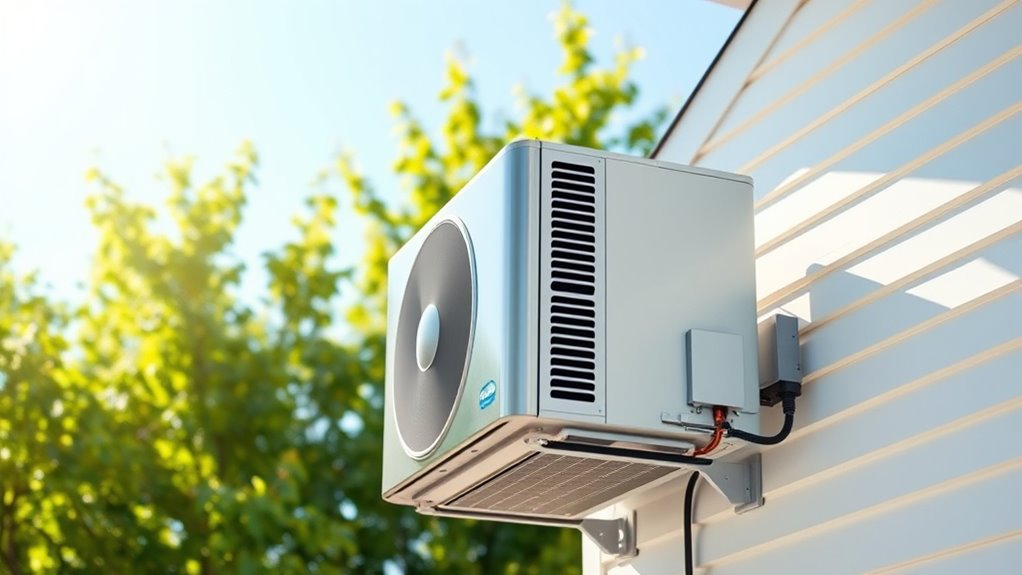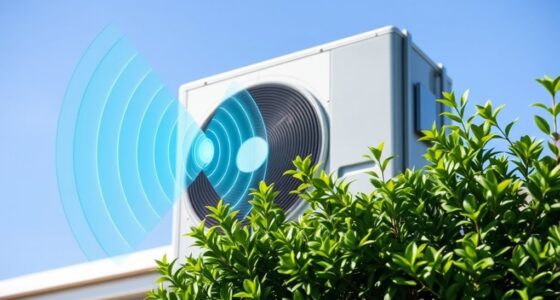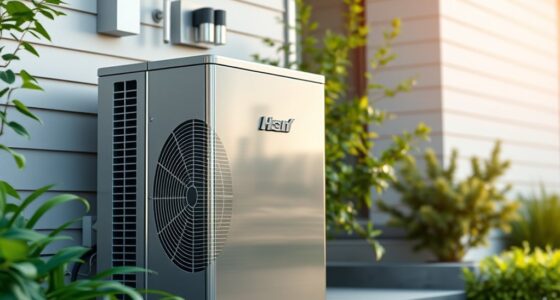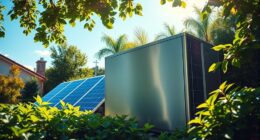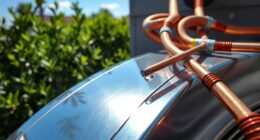Heat pumps improve your indoor air quality during cooling by actively circulating and filtering the air to remove dust, pollen, mold spores, and pollutants. They often feature built-in filters and can be paired with additional air purifiers, reducing allergens and airborne contaminants. Ductless models trap particles at the source and help control humidity, preventing mold growth. Proper maintenance ensures peak performance, so you enjoy cleaner, healthier air all summer long—exploring these benefits is easier than you think.
Key Takeaways
- Heat pumps circulate indoor air through built-in filters, capturing dust, pollen, and airborne pollutants during cooling.
- Ductless heat pumps reduce pollutant spread by trapping contaminants at their source, improving overall air quality.
- Regular filter maintenance and upgrades to high-efficiency filters enhance pollutant removal during cooling periods.
- Combining heat pumps with air purifiers or HEPA filters further reduces airborne allergens and improves indoor air quality.
- Proper humidity control via heat pumps prevents mold growth and dust mite proliferation, supporting healthier indoor environments during cooling.
How Heat Pumps Enhance Indoor Air Circulation During Summer
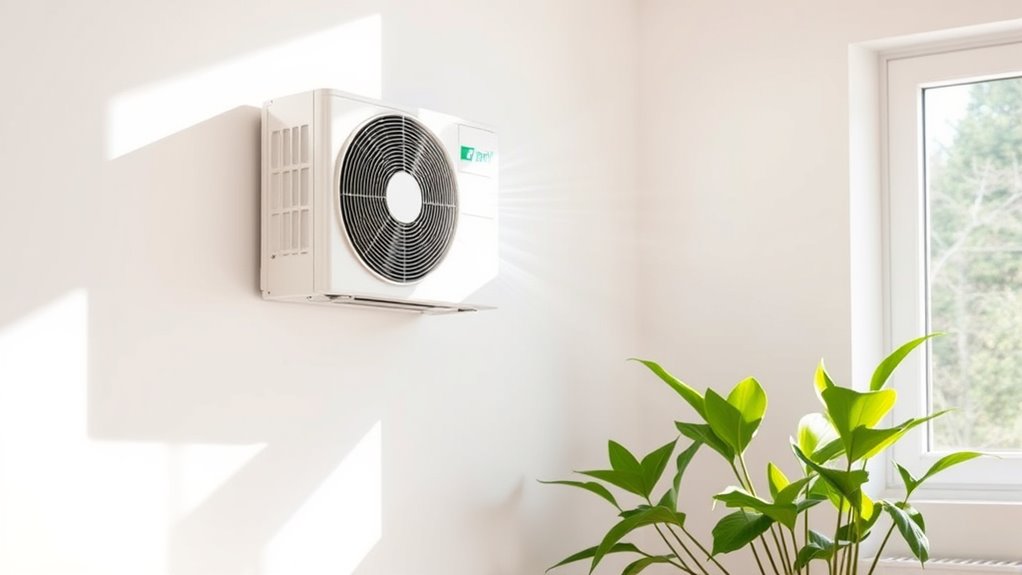
During summer, heat pumps actively improve indoor air circulation by continuously running compressors and fans. This constant movement prevents stagnation, ensuring fresh air flows throughout your space. Their built-in filters trap dust, pollen, and mold spores, which boosts air quality while cooling. Ductless heat pumps with air handlers help optimize airflow and reduce pollutant buildup in duct systems. Regular maintenance and filter replacements keep air exchange efficient, maintaining healthy indoor conditions. Proper ventilation, like exhaust fans and opening windows, complements the heat pump’s efforts by enhancing airflow and removing indoor air pollutants. Additionally, portable air quality monitors can help track and improve indoor air conditions. Understanding the importance of air circulation can further enhance indoor air quality, especially in the summer months. Ensuring proper air filtration can significantly improve the overall indoor environment by capturing smaller particles and allergens. Incorporating indoor air quality improvements, such as adding air purifiers, can further promote healthier air. Moreover, integrating advanced air purification technologies with heat pumps can help eliminate a broader range of airborne contaminants. Together, these features promote consistent circulation and better air quality, making your home more comfortable and healthier during hot summer months.
The Role of Filtration in Modern Heat Pumps

Modern heat pumps play a crucial role in maintaining indoor air quality through their built-in filtration systems. These air filters capture dust, pollen, mold spores, and airborne pollutants, improving your indoor environment. While heat pump filters primarily trap larger particles, they do a good job reducing particulate matter and allergens. Regularly cleaning or replacing filters is essential to keep filtration effective and prevent indoor air quality issues. Upgrading to high-efficiency filters can further enhance air purification, decreasing allergens and pollutants. For ideal indoor air quality, consider supplementing your heat pump with standalone HEPA air cleaners, which remove finer particles. Additionally, some heat pumps incorporate Glycolic Acid Benefits, which can help in reducing buildup on filters and maintaining their efficiency. Proper filter maintenance ensures optimal performance and prevents the growth of mold and bacteria within the system. Implementing air quality monitoring devices can help you track pollutant levels and optimize your filtration system accordingly. Understanding air filtration efficiency can guide you toward choosing the best filters for your needs. Staying informed about indoor air quality standards can help you create a healthier living environment. Overall, HVAC filtration in modern heat pumps considerably supports healthier indoor environments during cooling, helping you breathe easier and stay comfortable indoors.
Indoor Air Quality Benefits of Ductless Heat Pump Systems
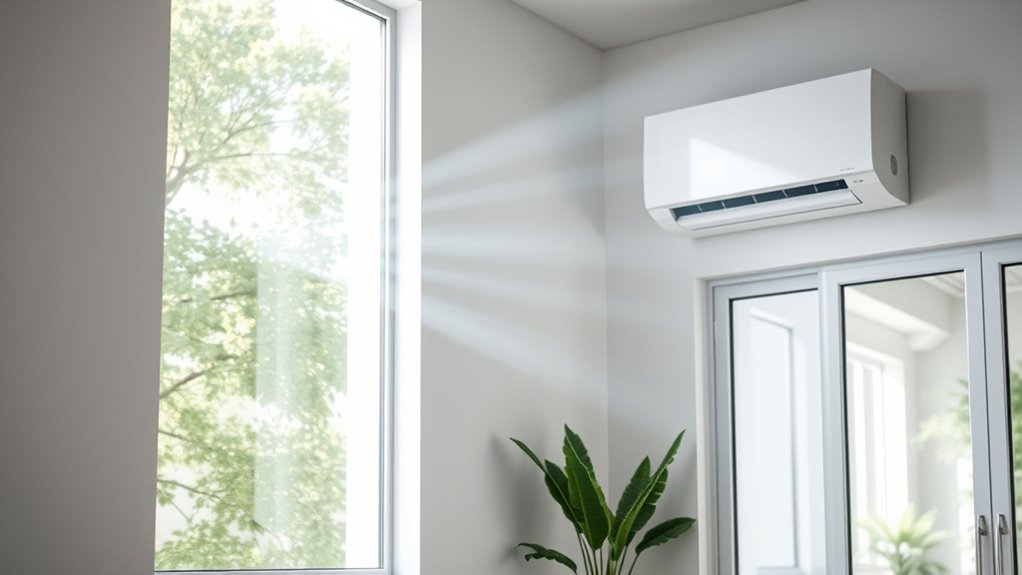
Ductless heat pump systems improve indoor air quality by using built-in filters that trap dust and other particles at their source. Because they don’t rely on ductwork, they prevent the spread of pollutants like mold spores and pet dander throughout your home. Plus, their ability to control humidity levels helps create a healthier, more comfortable environment. Additionally, some models feature advanced HEPA filtration technologies that enhance allergen removal for improved air cleanliness. As the integration of AI in entertainment continues to evolve, these systems could soon incorporate smart diagnostics to further optimize indoor air quality. Moreover, their versatility in installation allows for tailored solutions that maximize air purification in various living spaces. Regular maintenance and filter replacement are essential to ensure optimal performance, which can be facilitated through remote monitoring features available in modern heat pump systems. Incorporating air quality sensors can further help monitor and adjust indoor conditions for maximum health benefits.
Enhanced Filtration Capabilities
Have you ever considered how your heating and cooling system can also improve your home’s air quality? Ductless heat pumps excel at air filtration, trapping airborne pollutants like dust, pollen, and mold spores to boost indoor air quality. Their built-in filters prevent contaminants from circulating, reducing airborne contaminants and promoting a healthier indoor environment. Unlike traditional systems, ductless units minimize pollutant spread by avoiding ductwork reservoirs that can harbor dust and mold. Regular filter replacement maintains filter efficiency, ensuring consistent pollution control. For even better air quality improvement, combining ductless heat pumps with portable HEPA air cleaners offers an extra layer of filtration against fine particles and allergens. This enhanced filtration capability helps you breathe cleaner, healthier air every day.
Reduced Duct Contaminant Spread
By eliminating ductwork, ductless heat pump systems considerably reduce the spread of indoor pollutants throughout your home. Without ducts, airborne particles, pollutants, and mold are less likely to circulate between rooms, improving your overall indoor air quality. Ductless systems operate with individual air handlers, which lessen the risk of contaminant buildup and mold growth inside ducts. This setup prevents cross-contamination between spaces and limits the distribution of airborne particles that can cause allergies or respiratory issues. Additionally, regular cleaning and maintenance of the air handlers enhance filtration capabilities, further reducing pollutants and mold spores in your indoor air. Overall, ductless systems offer a cleaner, healthier environment by minimizing contaminant spread and maintaining consistent indoor air quality.
Improved Humidity Control
Did you know that controlling indoor humidity is key to improving your home’s air quality? Ductless heat pumps excel at humidity control by reducing indoor moisture levels through dehumidification during cooling cycles. This helps maintain the EPA-recommended 30-50% humidity range, preventing mold growth and dust mite proliferation. Proper humidity management minimizes indoor condensation, mold, and pest issues, enhancing overall air quality. Additionally, the ability of ductless systems to modulate humidity levels contributes to energy efficiency, reducing overall energy consumption while maintaining comfort. Furthermore, consistent humidity control can also prevent airborne allergens from becoming airborne, thereby improving respiratory health. Maintaining proper indoor humidity levels is crucial for air filtration and overall health, ensuring your indoor air remains fresh, safe, and more comfortable year-round. Regularly monitoring humidity levels can help optimize these benefits and maintain a healthy indoor environment.
Comparing Heat Pumps and Traditional Cooling Methods for Air Quality

When comparing heat pumps to traditional cooling methods, their impact on indoor air quality stands out as a key difference. Heat pumps circulate indoor air through filters that trap dust, pollen, and mold spores, helping to improve air quality during cooling. Many modern units have built-in filters that reduce larger airborne pollutants, promoting a healthier indoor environment. Unlike traditional cooling systems, such as window AC units, heat pumps are typically ductless, which minimizes duct leaks and reduces pollutant spread. Proper maintenance and filter replacement are essential to keep air purification effective. Additionally, using extra air purifiers alongside heat pumps can further remove finer particles and chemical pollutants, ensuring better indoor air quality compared to traditional cooling methods. Research indicates that incorporating air filtration technology into heat pump systems can significantly enhance their ability to improve indoor air quality. Implementing regular maintenance routines ensures continued optimal performance and air purification efficiency.
Impact of Heat Pumps on Indoor Humidity and Mold Prevention

Heat pumps play a vital role in controlling indoor humidity levels, which helps prevent mold growth and protect your health and home. During cooling mode, heat pumps dehumidify the air by removing moisture through moisture-condensation, aiding in moisture control. Maintaining indoor humidity between 30-50% reduces conditions favorable to mold spores, preventing mold development. Proper humidity management with heat pumps enhances air quality and supports a healthier indoor environment. When combined with dehumidification techniques, heat pumps effectively prevent excess moisture, especially in areas prone to dampness like basements or humid climates. Additionally, utilizing self watering plant pots can help maintain balanced indoor humidity levels, further supporting a healthier environment. Understanding GMC tuning options can also optimize your HVAC system’s efficiency and longevity, ensuring it operates effectively in controlling humidity. Regular maintenance and monitoring of air quality can further improve the effectiveness of your heat pump system in moisture regulation. Implementing humidity sensors can provide precise control and help maintain optimal moisture levels. Employing proper ventilation practices further enhances moisture control, reducing the likelihood of mold growth. By managing humidity levels, heat pumps contribute greatly to mold prevention and reduce the risk of structural damage caused by dampness, ensuring your indoor environment remains comfortable and safe.
Strategies for Maintaining Optimal Indoor Air Quality With Heat Pumps

Maintaining peak indoor air quality with heat pumps requires a proactive approach to system management and additional air purification methods. Regularly replacing or cleaning filters ensures effective removal of dust, pollen, and airborne pollutants, keeping your indoor environment healthy. Combining your heat pump with air purifiers that have HEPA filters helps trap fine particles like mold spores and allergens that filters alone might miss. Managing humidity levels between 30-50% with dehumidifiers and proper ventilation reduces mold growth and airborne mold spores. Scheduling annual professional maintenance keeps your system running efficiently, preventing filter clogging and identifying potential issues early. Installing exhaust fans in kitchens and bathrooms enhances ventilation, dilutes indoor pollutants, and supports ideal indoor air quality during cooling seasons. Additionally, understanding entertainment support hours at local parks and attractions can help you plan visits during less crowded times, reducing exposure to outdoor pollutants and creating a more comfortable indoor-outdoor environment.
How Upgrading to a Heat Pump Can Reduce Indoor Pollutants

Upgrading to a heat pump can markedly improve indoor air quality by eliminating the need for combustion-based heating systems that produce harmful pollutants like CO₂ and methane. Modern heat pumps feature built-in air filtration systems that trap indoor contaminants such as dust, pollen, and mold spores, reducing airborne pollutants. Switching from gas furnaces to electric heat pumps also cuts chemical emissions associated with burning fossil fuels, such as nitrogen oxides and carbon monoxide. Since heat pumps recirculate indoor air without bringing in outdoor pollutants, effective ventilation and filtration are essential to maintain healthy air quality. Upgrading your system prevents pollutant buildup caused by leaks, poor maintenance, or outdated filters, ensuring cleaner indoor air and a healthier environment.
The Importance of Regular Maintenance for Indoor Air Safety
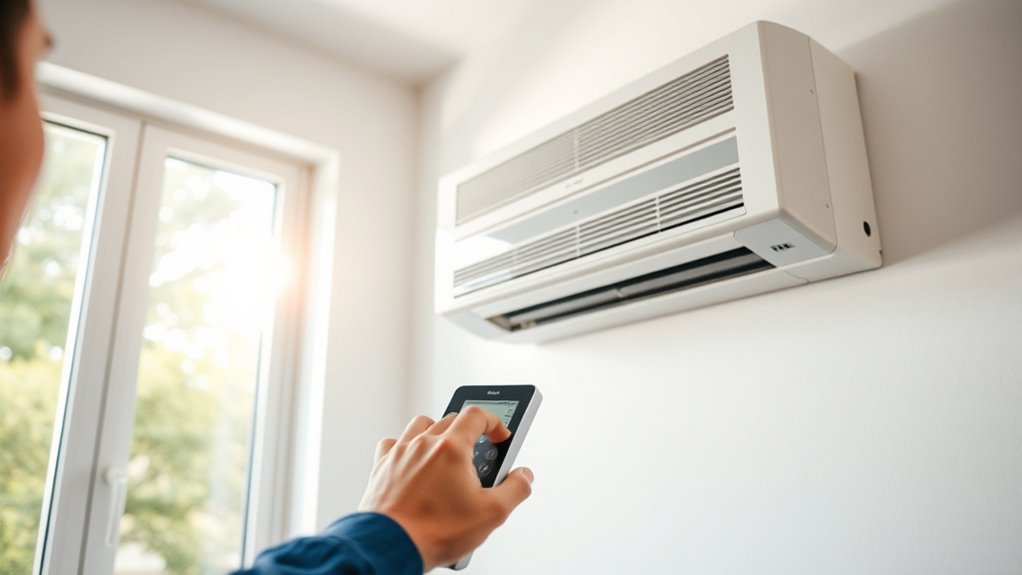
Regular maintenance keeps your heat pump running efficiently and helps prevent indoor air quality problems. Checking filters and scheduling professional tune-ups remove dust, mold, and pollutants before they circulate. Staying on top of these tasks guarantees a safer, healthier home environment.
Systematic Filter Checks
Since your heat pump’s air filters play a key role in trapping dust, pollen, and airborne pollutants, checking and replacing them regularly is essential for indoor air safety. Proper filter replacement guarantees your system maintains high filter efficiency, effectively removing dust and pollutants that can degrade indoor air quality. During system maintenance, HVAC cleaning includes inspecting filters for dirt buildup, which can hinder airflow and allow pollutants to circulate. Dirty filters markedly reduce dust removal and compromise indoor environment quality, impacting respiratory health. Most manufacturers recommend inspecting filters every 1 to 3 months, especially during peak seasons. Routine filter checks prevent mold growth, prolong system lifespan, and keep airborne pollutants under control, ensuring your indoor environment remains healthy and comfortable.
Professional Tune-Ups
Scheduling professional tune-ups for your heat pump is essential to maintaining indoor air safety. Regular system maintenance keeps filters and coils clean, which boosts indoor air quality and prevents pollutants. During these tune-ups, certified technicians inspect for refrigerant leaks, ensuring the system operates efficiently and safely. They also perform air filter replacements and thorough system inspections to prevent mold buildup and improve airflow efficiency. Proper maintenance reduces the risk of stagnant air and airborne contaminants, which can harm indoor air safety. Enrolling in maintenance plans ensures all critical components are checked regularly, supporting a healthier environment indoors. With professional tune-ups, you’ll enjoy cleaner air, better system performance, and peace of mind knowing your heat pump delivers safe, quality air.
Integrating Air Purifiers With Heat Pump Systems for Better IAQ
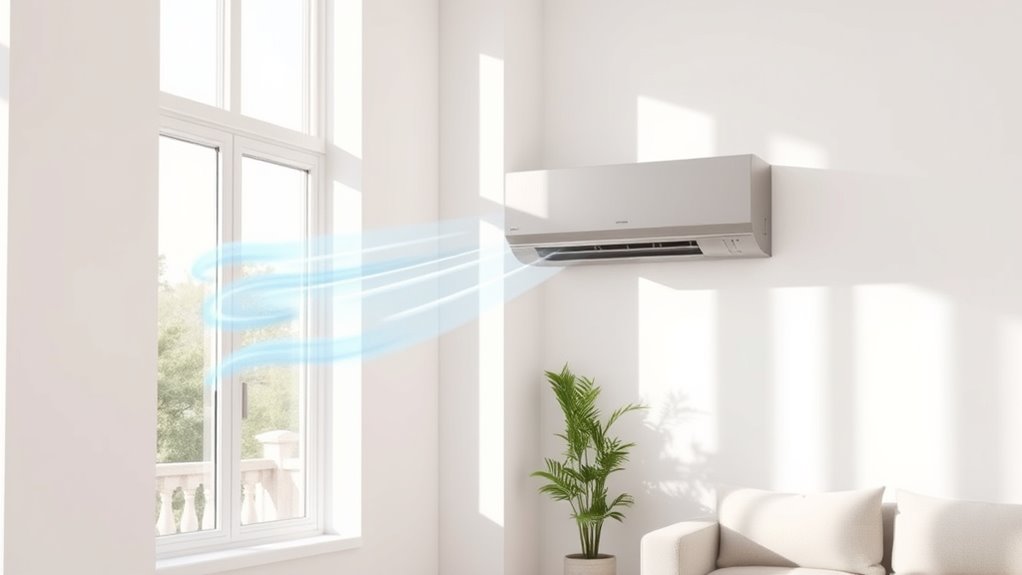
Integrating air purifiers with heat pump systems can greatly enhance indoor air quality by actively reducing airborne pollutants like dust, pollen, mold spores, and pet dander. Air purifiers equipped with HEPA filters remove over 99.97% of particles as small as 0.3 microns, complementing heat pump filtration and targeting indoor pollution more effectively. Portable air cleaners placed in high-traffic or pollution-prone areas boost overall IAQ by filtering out cooking fumes, smoke, scented products, and outdoor infiltration. Proper placement and regular maintenance of both the heat pump and air purifiers are essential to sustain ideal system performance. This integration not only improves air quality but also helps prevent system strain, ensuring cleaner indoor environments and healthier living spaces.
Frequently Asked Questions
Are Heat Pumps as Good at Cooling as Air Conditioners?
You wonder if heat pumps cool as effectively as air conditioners. The truth is, modern heat pumps are just as good at cooling, often matching or exceeding traditional ACs’ efficiency with SEER ratings of 13-20 or higher. They use the same refrigeration cycle, providing reliable comfort during hot days. Plus, new tech like variable-speed compressors makes their cooling performance even better, so you can count on them for a cool, comfortable home.
Do Heat Pumps Improve Air Quality?
You might wonder if heat pumps improve air quality. They do, because their built-in filters trap dust, pollen, and airborne particles, helping keep indoor air cleaner. Since they recirculate indoor air instead of pulling in outdoor pollutants, your environment stays healthier. Regular filter maintenance and professional tune-ups boost their effectiveness. Adding HEPA air cleaners can further reduce allergens, making your indoor space even fresher and safer.
At What Air Temperature Do Heat Pumps Become Ineffective?
You’re wondering when heat pumps stop working effectively. Generally, they become less efficient at outdoor temperatures below 20°F to 25°F (-6°C to -4°C). Many standard models struggle below 10°F (-12°C), and performance drops sharply under 0°F (-18°C). Cold climate heat pumps can work down to -13°F (-25°C), but even these may need auxiliary heating at extreme cold. So, your heat pump’s effectiveness depends on the specific model and outdoor temperature.
Do I Need an Air Purifier if I Have a Heat Pump?
Think of your indoor air as a garden that needs extra care. A heat pump alone is like watering your plants—it keeps humidity balanced but doesn’t remove weeds or pests. To keep your air fresh and healthy, you should add a HEPA air purifier. It acts like a gardener’s hand, filtering out allergens, dust, and pollutants, ensuring your indoor environment stays clean and breathable.
Conclusion
Switching to a heat pump is like opening a window to fresh air in a stuffy room—you’ll notice the difference in air quality. By improving circulation, filtering out pollutants, and controlling humidity, heat pumps create a healthier indoor environment. Keep up with regular maintenance and consider adding air purifiers to boost results. With these upgrades, your home becomes as inviting and crisp as a cool breeze on a summer day.
